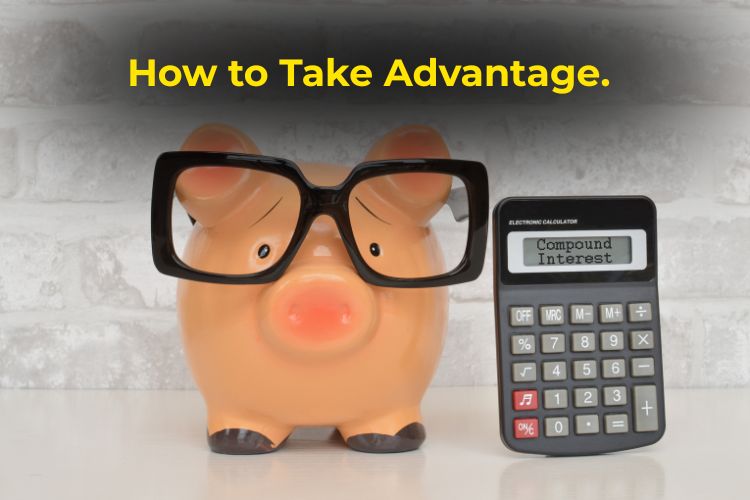If there’s one concept in personal finance that can truly change your life — without requiring constant effort — it’s compound interest. Often called the “eighth wonder of the world” (a phrase sometimes attributed to Albert Einstein), compound interest is the hidden force behind how ordinary people can build extraordinary wealth over time.
In this article, you’ll learn what compound interest is, how it works, real-life examples, and practical steps to take advantage of it for your own financial freedom.
What Is Compound Interest?
Compound interest is the process of earning interest not only on your initial investment but also on the interest that your investment has already generated.
Think of it like planting a tree:
- In year one, it produces fruit.
- In year two, both the tree and the fruit seeds that fell produce more trees.
- Over decades, you don’t just have one tree — you have an entire forest.
This is why compound interest is so powerful: it creates a snowball effect where money earns money, and then that new money earns even more.
The Formula of Compound Interest
The formula is:
A = P(1 + r/n)^(nt)
Where:
- A = Final amount
- P = Principal (initial investment)
- r = Annual interest rate
- n = Number of compounding periods per year
- t = Time (in years)
💡 Don’t worry too much about the math. The most important takeaway is this: the more time your money has, the bigger the exponential growth.
Why Time Matters More Than Amount
Let’s look at an example.
- Alex, age 25, invests $200 per month for just 10 years, then stops.
- Jordan, age 35, invests $200 per month and keeps going for 30 years.
Assuming a 7% annual return:
- Alex invests a total of $24,000 → grows to ~$250,000 by age 65.
- Jordan invests a total of $72,000 → grows to ~$245,000 by age 65.
✅ Even though Jordan invested three times more, Alex ends up with slightly more because he started earlier.
This is the magic of compounding: time beats timing.
Where You Encounter Compound Interest in Real Life
Compound interest isn’t just theoretical. You see it in many areas of finance, both positive and negative.
1. Savings Accounts and CDs
- Compounded daily or monthly.
- Very safe, but low returns (around 1–4% depending on the bank).
- Best for short-term goals like building an emergency fund.
2. Stock Market Investments
- Compounding happens through price growth and dividend reinvestment.
- Historically, stocks average 6–10% annual returns.
- Ideal for long-term wealth building, especially retirement.
3. Retirement Accounts (401(k), Roth IRA, Traditional IRA)
- Tax advantages amplify compounding.
- Employer matching = instant return on investment.
- Consistent contributions over 30+ years can turn modest savings into millions.
4. Real Estate Investments
- Rental income reinvested + property appreciation.
- A mix of cash flow and long-term growth makes real estate another example of compounding.
The Power of Reinvesting
One of the easiest ways to supercharge compound interest is by reinvesting your earnings.
When you receive:
- Dividends
- Interest payments
- Capital gains
👉 Instead of cashing them out, reinvest them. This keeps your money working and multiplying.
Tools like DRIPs (Dividend Reinvestment Plans) and automatic reinvestment features in brokerages make this effortless.
Simple vs. Compound Interest: Why It Matters
| Feature | Simple Interest | Compound Interest |
|---|---|---|
| Interest earned on | Principal only | Principal + accumulated interest |
| Growth pattern | Linear (straight line) | Exponential (curved upward) |
| Common example | Car loans, some bonds | Savings accounts, investments |
✅ Compound interest is what makes long-term investing exponentially more rewarding.
See also: How to Build a Diversified Investment Portfolio From Scratch.

How to Take Advantage of Compound Interest
1. Start Early — Even Small Amounts Matter
The earlier you begin, the more time your money has to multiply. Even $50 a month started at age 20 can grow into hundreds of thousands by retirement.
2. Invest Consistently
Set up automatic monthly contributions to your retirement or investment accounts. This removes the guesswork and ensures steady compounding.
3. Reinvest Earnings
Don’t take dividends or interest as cash unless necessary. Keep them invested to accelerate growth.
4. Use Tax-Advantaged Accounts
Accounts like a 401(k), Roth IRA, or HSA let your money compound without losing gains to yearly taxes.
5. Avoid Interruptions
Every withdrawal interrupts compounding. Treat investments as untouchable long-term money unless it’s a true emergency.
6. Increase Contributions with Raises
Every time your income grows, increase your savings rate. Even an extra 1–2% per raise builds huge long-term wealth.
Compound Interest Can Work Against You Too
While it’s your best friend when investing, it’s your worst enemy when you’re in debt.
Example: Credit Cards
- Average APR = 20%
- Interest compounds daily
- A $2,000 unpaid balance can balloon quickly into $3,000 or more if ignored
That’s why paying off high-interest debt is critical. Otherwise, you’re letting compound interest work against you.
Common Mistakes That Kill Compounding
- Starting late — every year lost reduces your long-term growth.
- Cashing out investments too early — selling after a market dip locks in losses.
- Not reinvesting dividends — missing out on compounding fuel.
- Carrying high-interest debt — which cancels out the benefits of investing.
- Chasing risky investments — losing capital breaks the compounding cycle.
Tools to Track and Boost Compounding
- Brokerage platforms (Fidelity, Vanguard, Charles Schwab) — auto-investment + DRIP.
- Apps like Acorns or Robinhood — allow small contributions to grow.
- Retirement calculators — project how contributions compound over time.
- Spreadsheets — DIY tracking for those who like numbers.
A Generational Wealth Secret
Compound interest isn’t just for you — it can build multi-generational wealth.
Example:
- Investing $5,000 at birth for a child, at 7% average return, grows to $150,000 by age 65 without adding a penny more.
- Imagine if you contribute $100/month from birth — it grows into over $400,000.
This is why many parents and grandparents open custodial investment accounts.
Final Thoughts: Start Now — Your Future Self Will Thank You
Compound interest is a quiet but unstoppable force. At first, growth seems slow, almost invisible. But given time, it accelerates like a snowball rolling downhill, turning small, steady investments into life-changing wealth.
The key lessons are simple:
- Start as early as possible.
- Be consistent.
- Reinvest your earnings.
- Avoid unnecessary interruptions.
💡 Remember: wealth isn’t built overnight — it’s built over decades.
Your future self won’t thank you for the things you bought and forgot. They’ll thank you for the freedom, security, and opportunities you created by letting compound interest work its magic.
FAQ – How Compound Interest Works and Why It’s So Powerful.
What is compound interest and how does it work?
Compound interest is the process of earning interest on both your initial investment and the interest it has already generated. Over time, this leads to exponential growth, making your money grow faster the longer it stays invested.
Why is starting early important with compound interest?
The sooner you start, the more time your money has to compound. Even small contributions made early can grow significantly more than larger contributions made later, thanks to the power of time.
Where does compound interest apply in real life?
You’ll find compound interest in savings accounts, retirement accounts (like 401(k)s and IRAs), and investments such as stocks and ETFs — especially when dividends and returns are reinvested.
How can I take advantage of compound interest?
Start as early as possible, invest consistently, avoid withdrawing funds, use tax-advantaged accounts, and always reinvest dividends and earnings to keep your money compounding.
Can compound interest work against me?
Yes. Debt like credit cards also compounds — but negatively. Interest accumulates daily, and if unpaid, it can cause your debt to grow rapidly. Avoid carrying balances to prevent compounding from working against you.

